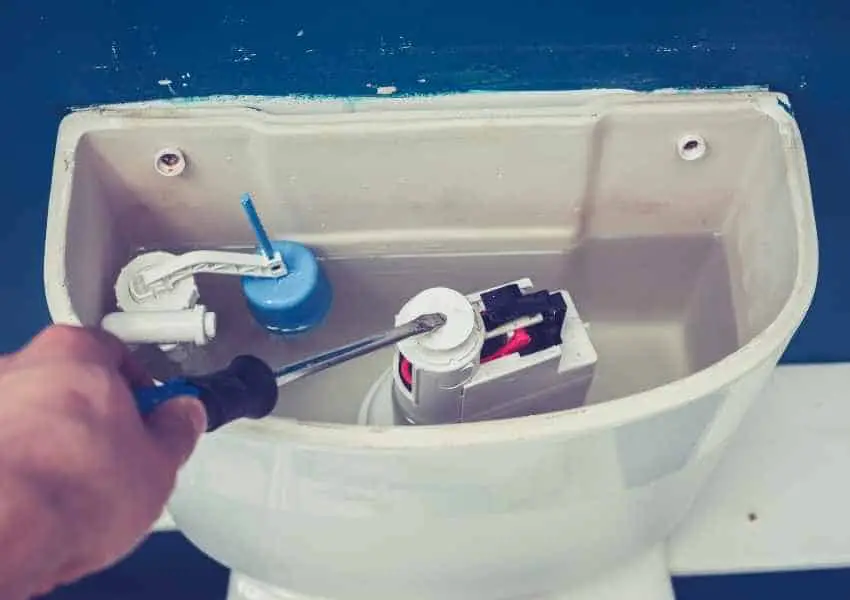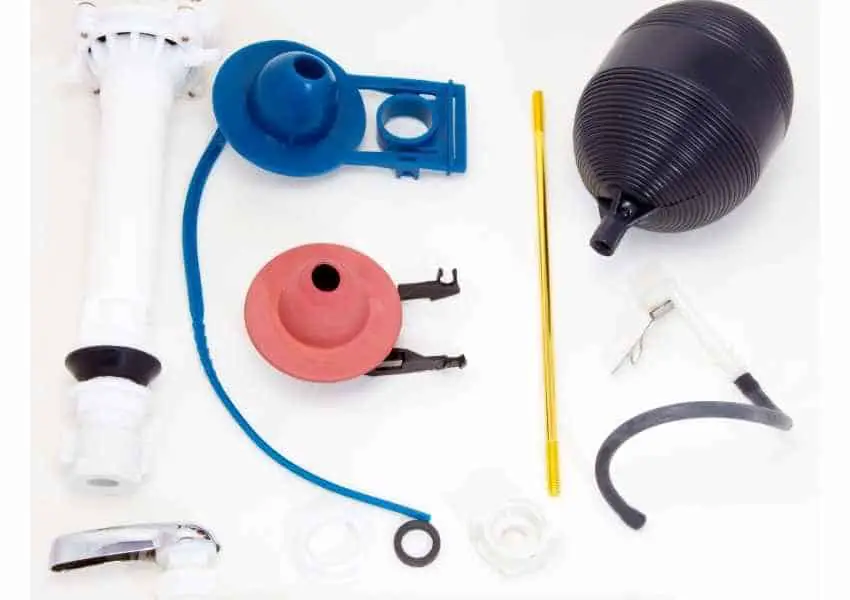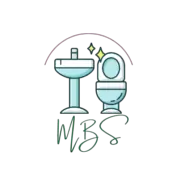Your toilet keeps running and is using more water than before. You hope that the increase in your bill isn’t because of this, but you don’t know what else could be causing it.
In order to solve a problem we need to understand it fully, otherwise simply putting band-aids on the issue won’t fix anything. The first step for fixing a running toilet is walking through each step with clarity, so you can find out where the problem might be coming from.
This guide will walk you through each step to understanding your running toilet and how to fix it.

What causes a running toilet?
There can be many reasons why a toilet might continue to run. For example, the float may be stuck or not adjusted properly. The flapper valve may be misaligned or damaged. Or it could simply be that the fill valve is not operating correctly.
Here are some of the common problems:
Faulty overflow valve
An overflow valve is a device that prevents a toilet from overflowing. When the water level in the toilet tank goes too high, the overflow valve will cause water to flow out of the toilet. This can waste up to 200 gallons of water per day.
The most common cause of a running toilet is a malfunction with the fill valve.
Broken flush valve
A broken flush valve is a serious problem that can lead to wasted water and higher bills. The flush valve is positioned in the center of the tank and allows water to exit the tank when flushed. If the valve is broken, water will continue to enter the tank after the flush is completed. This can be fixed by adjusting the float on the fill valve.
Leaky fill valve
A fill valve is a small fitting that helps regulate the amount of water that goes into a toilet. If the fill valve is not working properly, water can overflow and cause a running toilet. A running toilet can waste a lot of water and cause expensive bills. Easy-to-catch signs of a running toilet include hearing it and seeing loose handles.
Cracked flapper seal
A cracked flapper seal is a sign of a leak. The most common reason for a running toilet is a cracked flapper seal. To fix the issue, you need to replace the fill valve.
A cracked flapper seal is caused by a stuck handle and can be fixed by realigning the float or replacing the fill valve. A wax ring can last around 30 years, so they don’t need to be replaced often. If the fixes don’t work, it is best to call a professional.
Broken flapper chain
A flapper chain is a device that helps to open and close the flap on a toilet. If the chain is caught or tangled, it will just need to be adjusted. To fix a running toilet, you must find the source of the leak.
A flapper chain can become detached or too long, causing the toilet to run. In some cases, the flapper chain may need to be shortened, and in other cases, the float arm and float ball may need to be replaced.
Disconnected toilet handle
If the toilet handle is disconnected, the water will not be able to flow into the bowl and the toilet will not flush. To fix a running toilet, you must find the source of the leak. Worn-out flappers are common causes of running toilets.
The toilet might not be flushing properly because of a faulty flapper or chain. If the flapper or chain looks to be in working condition, but the toilet is still not flushing properly, you may need to adjust the float arm or float ball. A plumber will be able to determine the problem and fix it during a service call.
Problems with the Float Ball
The float ball is a small ball that floats on top of the water in the toilet tank. When the handle is pushed, water is released from the tank into the bowl. The float ball can cause a running toilet if it leaks, allowing water to trickle into the tank. The most common solution is to check the float arm and replace the flapper if necessary.
Can Running Toilet Impact Your Utility Bill?
A running toilet can increase your water bill in a few ways. First, if there is a leak, water will continuously run until the issue is fixed, which can waste a lot of water and lead to a high bill. Second, toilets use different amounts of water depending on their type and how often they’re flushed.
If you have an older toilet that uses more water per flush, or if you live in a household where the toilet is used frequently throughout the day, this can also lead to an increased water bill.
Lastly, if you don’t regularly clean your toilet, it can become clogged more easily, which can cause leaks and other issues that require extra repairs. To avoid all of these potential problems, be sure to check for leaks regularly, turn off the water when you’re not using it, and clean your toilet on a regular basis.
How do you fix a running toilet?
Follow these steps to fix a running toilet:
Testing The Flapper
To test the flapper for a running toilet, you can use a dye tablet or food coloring. A running toilet wastes water and costs money. If you hear a “hissing” sound or a constant stream of running water from your toilet, it means you probably have a leak.
If the flapper becomes brittle and breaks down, it will cause the toilet to sound like it’s constantly running. To test if a toilet is running, attach the chain to the flush lever arm and check for water running in the tank. If there is no water running in the tank, try a water dye test.
Check If The Fill Valve Has a Leak
If you think your fill valve may be leaking, the best way to check is by flushing the toilet. If the water in the tank stops filling up before it reaches the top, then you likely have a leak.
To fix this, you can try adjusting the float arm. If that doesn’t work, then you will need to replace the fill valve.
Replace Old Toilet Fill Valve
To replace an old toilet fill valve, you’ll need to turn off the water supply, flush the toilet, and sponge the tank. Unscrew the fill valve locknut and lift out the old fill valve.
Inspect the inner workings of your toilet to determine if there is a leak. When the tank is flushed, the flapper is raised, allowing water to flow into the bowl and clear out waste. If there’s too much water in the tank, it will overflow and cause problems.
Installing The New Fill Valve
If you have a high water bill and your overflow pipe is higher than the critical level mark on your fill valve, you can save on your water bill by shortening it with a hacksaw so it’s one inch lower.
Connecting the Fill Tube
To fix a running toilet, you will need to connect the fill tube to the fill valve nipple. To do this, simply attach one end of the tube to the nipple and the other to the angle adapter. Clip the angle adapter onto the overflow pipe and turn on the water. Test-flush your toilet to ensure it is working properly.
How Can You Prevent a Running Toilet?

There are several ways to prevent a running toilet. Here are some of the common problems:
Step 1: Check the flapper
If your toilet is having issues flushing properly, the first thing you should check is the flapper. The flapper is a rubber valve that sits at the bottom of the water tank and controls the flow of water from the tank to the bowl. If the flapper is not working properly, it may need to be replaced.
To check the flapper, lift up the lid of the water tank and look inside. If you see a chain that is caught or tangled, this may be causing your issue. Try adjusting the chain or untangling it to see if this fixes the problem. If not, you may need to replace the flapper.
To replace the flapper, turn off the water to your toilet and flush to empty the tank. Disconnect any chains attached to the old flapper and remove it. Install a new flapper in its place and reattach any chains. Turn on your water supply and flush your toilet to test it out.
Step 2: Check the float
The float is a device in the toilet that prevents water from flowing into the tank. It is usually located near the top of the tank and is adjustable. To adjust the float, you can use a screwdriver to raise or lower it.
If the float is not working properly, it may be due to a problem with the flapper. You may also need to check for leaks in the tank and fix them if necessary. A running toilet can be expensive to fix over time, so it’s important to prevent it by maintaining the float.
Step 3: Check the fill valve
The fill valve is a valve that is attached to the incoming water line and regulates the amount of water that comes into the toilet tank. There is a float on the fill valve that signals the water line to stop when the tank is full.
The fill valve can be a problem and needs to be fixed for around $50. You can check the water tank by looking for the flap and try a water dye test if it’s not clear what the issue is.
To check the fill valve, wait 20 minutes after flushing and add food coloring or dye to the top tank. If there is an issue with the fill valve, it will become quickly visible with colored water escaping.
Step 4: Check the tank
If the water in your tank isn’t flushing correctly, the first thing you should check is the stopper flap. If the problem is with the flap, it will be quickly visible. If the problem is with the flush valve, it may be more difficult to see.
If the problem is not immediately apparent, you can try a water dye test. To do this, add a few drops of food coloring to the water in the tank and wait a few minutes. If the dye appears in the bowl, it means there is a leak in either the flapper or flush valve.
If there are problems with either of these valves, you’ll need to adjust the amount of water coming into the tank. If you’re still having problems with your tank after adjusting these valves, it might be a good idea to replace them.
Step 5: Check the bowl
If your toilet bowl is the problem and the water won’t stop running, you may need to check for a blocked chain or flap on the inside of the tank. You can also try adding food coloring or dye to the tank to see if water is leaking into the bowl.
If your water bill is high, it’s likely that there is a leak in your toilet. To find the leak, add a drop of food coloring to the tank and set a timer for 30 minutes. When the timer goes off, take a look inside the bowl to see if there is any water leaking.
If you notice colored water in the bowl, there is probably a leak in your hands. Fixing the leak will lower your water bill.
FAQs
How much water does a running toilet waste?
A running toilet can waste a lot of water. To calculate the amount of water wasted, you need to identify the source of the leak. Running toilets typically waste 6-3.6 gallons of water per flush.
If there are minor leaks, you can reduce the amount of water wasted by half. If there are larger leaks, you can double the amount of water wasted.
How do I know if I have a running toilet?
There are a few signs that may indicate a running toilet, which include:
- Hearing running water after the toilet has been flushed
- noticing moisture or stains around the toilet base
- seeing water around the base of the toilet
- an increased water bill.
If you notice any of these signs, it’s important to check for leaks and have them fixed as soon as possible to prevent any further damage or costs. T
o test for leaks, add food dye to the water in the tank and wait 10-15 minutes. If there is color present in the bowl after this time, there is a leak present and you should call in a professional for an inspection.
What are the consequences of a running toilet?
A running toilet can be a sign of a bigger problem. If water is constantly running after the toilet has been used, it means the tank is full and there may be a leak. leaks can lead to costly water bills and repairs. It is important to check for leaks even if you only suspect them.
What are some other ways to save water?
There are many ways to save water. One way is to install low-flow heads and faucets. This will save water in the long run. Another way to save water is by using faucet aerators and fixing leaks. Don’t wait for the water to run cold; store it in the refrigerator.
This will save energy. Save water by taking shorter showers, using low-flow shower heads, and installing water-saving shower heads. Another way to save water is to displace water in tanks with plastic jugs filled with water or pebbles.
Use washing machines only when there’s a full load, scrape plates instead of rinsing, and use low-volume washing machines to save even more water.
Wrap water heaters with insulation to save energy as well. Water outdoor plants and landscaping in the evening hours to avoid wasting resources during the daytime heat hours. Collect rainwater for use in plants and landscaping around your home as well!
Use native plants to reduce your overall watering needs too! Finally, mulch around plants and trees helps reduce evaporation rates so that your irrigation system isn’t working overtime needlessly!
Final Thought
I hope you enjoy this article on ‘Can a Running Toilet Increase Your Water Bill’ and learn something new about saving water and how to fix a running toilet!
If you enjoyed this article, please consider sharing it with your friends and family and if you have any comments please feel free to use the Contact Us page. Thanks for reading!
